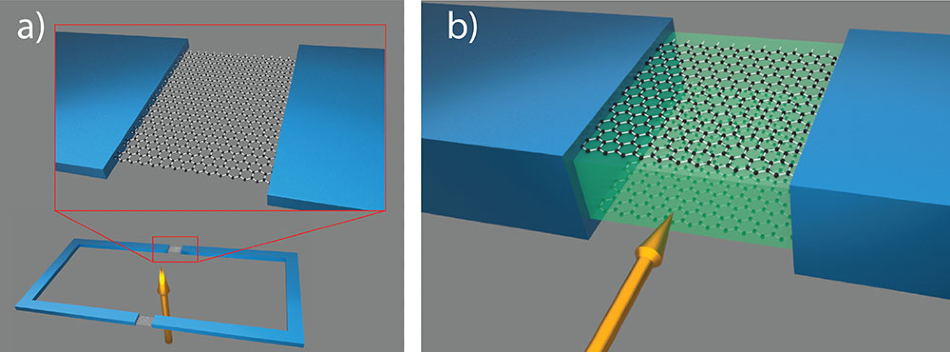Sep 8 2020
At the University of Basel, physicists have designed a compact instrument capable of detecting very small magnetic fields.
 (a) A conventional superconducting quantum interference device (SQUID) consists of a superconducting ring interrupted at two points by weak links (in this case a graphene layer). (b) The new SQUID is made up of a stack of two-dimensional materials, including two graphene layers separated by a thin film of boron nitride. Image Credit: University of Basel, Department of Physics.
(a) A conventional superconducting quantum interference device (SQUID) consists of a superconducting ring interrupted at two points by weak links (in this case a graphene layer). (b) The new SQUID is made up of a stack of two-dimensional materials, including two graphene layers separated by a thin film of boron nitride. Image Credit: University of Basel, Department of Physics.
Two atomically thin layers of graphene form the core of the superconducting quantum interference device (SQUID). The team combined these layers with boron nitride. Instruments such as these find applications in fields such as medicine, apart from being used to study new materials.
Scientists typically use SQUIDs to quantify extremely faint magnetic fields. In the field of medicine, these devices are used to monitor the activity of the heart or brain, for instance.
In the field of earth sciences, SQUIDs are used to determine the composition of rocks or detect groundwater flows. Moreover, these devices find an extensive range of uses in basic research and other applied fields.
Led by Professor Christian Schönenberger from the University of Basel’s Department of Physics and the Swiss Nanoscience Institute, the research team has now successfully developed one of the smallest SQUIDs. The scientists have reported their achievement in the scientific journal Nano Letters.
A Superconducting Ring with Weak Links
A standard SQUID includes a superconducting ring interrupted at two points by a very thin film with typical insulating or conducting properties. Such points are called weak links and should be so thin that the electron pairs that cause superconductivity can tunnel through them.
Recently, scientists also started using nanomaterials like nanowires, nanotubes, or graphene to design the weak links that link the two superconductors.
Due to their configuration, SQUIDs exhibit a critical current threshold above which the resistance-free superconductor turns into a conductor with normal resistance. This critical threshold is governed by the magnetic flux that passes through the ring.
The team can come up with conclusions regarding the strength of the magnetic field by performing accurate measurements of this critical current.
SQUIDs with Six Layers
Our novel SQUID consists of a complex, six-layer stack of individual two-dimensional materials. If two superconducting contacts are connected to this sandwich, it behaves like a SQUID—meaning it can be used to detect extremely weak magnetic fields.
David Indolese, Study Lead Author, University of Basel
Inside the SQUID, there occur two graphene monolayers isolated by an extremely thin layer of insulating boron nitride.
In this arrangement, the graphene layers tend to be the weak links. However, in contrast to a standard SQUID, where they are placed next to each other, in the new model, they are placed one on top of the other, and aligned horizontally.
As a result, our SQUID has a very small surface area, limited only by the constraints of nanofabrication technology.
Dr Paritosh Karnatak, University of Basel
Dr Paritosh Karnatak belongs to Schönenberger’s Team.
The height of the small device for quantifying magnetic fields is just about10 nm—approximately one-thousandth of the thickness of a strand of human hair. The instrument can induce supercurrents that flow in extremely narrow spaces.
Furthermore, it is possible to adjust its sensitivity by altering the distance between the graphene layers. The team could also improve the signal strength by using electrical fields, thus further improving the measurement accuracy.
Analyzing Topological Insulators
The main aim of the Basel researchers in developing the innovative SQUIDs was to investigate the edge currents of topological insulators. At present, topological insulators are a point of focus of innumerable research groups worldwide.
They act as insulators from the inside, whereas on the outside or along the edges, they conduct current almost without loss, which makes them potential candidates for an extensive range of applications in the field of electronics.
With the new SQUID, we can determine whether these lossless supercurrents are due to a material’s topological properties, and thereby tell them apart from non-topological materials. This is very important for the study of topological insulators.
Christian Schönenberger, Professor, Department of Physics, University of Basel
In the days to come, SQUIDs could even be utilized as low-noise amplifiers for high-frequency electrical signals or, for example, to detect local brainwaves (magnetoencephalography), as their compact design enables a huge number of devices to be linked in series.
The paper is the result of close collaboration among researchers from the University of Basel, the University of Budapest, and the National Institute for Material Science in Tsukuba (Japan).
Research News: A new SQUID for nanostructures
Video Credit: University of Basel.
Journal Reference
Indolese, D. I., et al. (2020) Compact SQUID Realized in a Double-Layer Graphene Heterostructure. Nano Letters. doi.org/10.1021/acs.nanolett.0c02412.